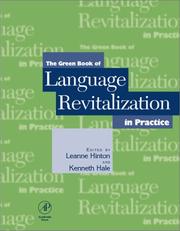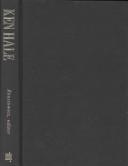| Listing 1 - 9 of 9 |
Sort by
|

ISBN: 0123493536 0123493544 9789004261723 9004261729 9789004254497 9004254498 9780123493538 9780123493545 Year: 2001 Publisher: San Diego
Abstract | Keywords | Export | Availability | Bookmark
 Loading...
Loading...Choose an application
- Reference Manager
- EndNote
- RefWorks (Direct export to RefWorks)
With world-wide environmental destruction and globalization of economy, a few languages, especially English, are spreading rapidly in use, while thousands of other languages are disappearing, taking with them important cultural, philosophical and environmental knowledge systems and oral literatures. We all stand to suffer from such a loss, none more so than the communities whose very identity is being threatened by the impending death of their languages. In response to this crisis, indigenous communities around the world have begun to develop a myriad of projects to keep their languages alive. This volume is a set of detailed accounts about the kind of work that is going on now as people struggle for their linguistic survival. It also serves as a manual of effective practices in language revitalization. Key Features * Sections on language policy, language planning, revitalization of indigenous languages of national prominence vs. revitalization in small speech communities, second language teaching with emphasis on immersion and communicative competence, minority language literacy, the use of media and technology in language revitalization, training, and the revitalization of languages with nonnative speakers * 23 case studies of language revitalization in practice, from Native American languages, Australian languages, Maori, Hawaiian, Welsh, Irish, and others, written primarily by authors directly involved in the programs * 10 chapters by Hale and Hinton that are detailed overviews of the various kinds of programs and methods that are in practice * Introductions and maps for each of the languages that are represented in the volume, to familiarize the reader with their history, linguistic structure and sociolinguistic features * Strong representation in authorship and viewpoint of the people of the communities whose languages are threatened, giving the readers an inside understanding of the issues involved and the community-internal attitudes toward language l
Language revival. --- Language and languages --- Language renewal --- Language revitalization --- Renewal, Language --- Restoration of languages --- Revitalization, Language --- Revival of languages --- Sociolinguistics --- Restoration --- Revival
Book
ISBN: 1760464473 9781760464479 Year: 2021 Publisher: Canberra ANU Press
Abstract | Keywords | Export | Availability | Bookmark
 Loading...
Loading...Choose an application
- Reference Manager
- EndNote
- RefWorks (Direct export to RefWorks)
Classical Aboriginal societies in Australia have commonly been described in terms of social organisation and local organisation. This book presents rich detail on a third and related domain that has not been given the same kind of attention: linguistic organisation.
Native title (Australia) --- Wik-Mungkan (Australian people) --- Wik-Mungkan language. --- Wik-Ngathan language. --- Wik Mungkan language Y57. --- Wik Ngatharr language Y51. --- Wik Ngathan language Y54. --- Wik Elken language Y49. --- Wik Epa language Y52. --- Wik Adinda language Y46. --- Wik-Keyangan language Y173. --- Wik Mungkan people Y57. --- Wik Ngatharr people Y51. --- Wik Ngathan people Y54. --- Wik Elken people Y49. --- Wik Epa people Y52. --- Middle Paman languages --- Wik-Ngathana language --- Paman languages --- Munggan language --- Mungkan language --- Munkan language --- Wik-Munghn language --- Wik-Munkan language --- Wikmungkan language --- Wikmunkan language --- Aboriginal Australians --- Ethnology --- Monkanu (Australian people) --- Munggan (Australian people) --- Munggano (Australian people) --- Munkan (Australian people) --- Munkan tribe --- Munkanj (Australian people) --- Munkanu (Australian people) --- Wik Mongkan (Australian people) --- Wik Monkan (Australian people) --- Wik-Munkan (Australian people) --- Wik Munghn (Australian people) --- Wikmungkan (Australian people) --- Wikmungken (Australian people) --- Land titles --- Torres Strait Islanders --- Aboriginal title (Australia) --- Australian aboriginal title --- Land tenure --- Wik people --- Aboriginal languages --- Cape York --- Multilingualism
Book
Abstract | Keywords | Export | Availability | Bookmark
 Loading...
Loading...Choose an application
- Reference Manager
- EndNote
- RefWorks (Direct export to RefWorks)
With world-wide environmental destruction and globalization of economy, a few languages, especially English, are spreading rapidly in use, while thousands of other languages are disappearing, taking with them important cultural, philosophical and environmental knowledge systems and oral literatures. We all stand to suffer from such a loss, none more so than the communities whose very identity is being threatened by the impending death of their languages. In response to this crisis, indigenous communities around the world have begun to develop a myriad of projects to keep their languages alive. This volume is a set of detailed accounts about the kind of work that is going on now as people struggle for their linguistic survival. It also serves as a manual of effective practices in language revitalization.Following are the key features: 23 case studies of language revitalization in practice, from Native American languages, Australian languages, Maori, Hawaiian, Welsh, Irish, and others, written primarily by authors directly involved in the programs; short introductions situate the languages, to help make the languages more 'real' in the minds of readers; each chapter gives a detailed overview of the various kinds of programs and methods in practice today; introductions and maps for each of the languages represented familiarize the reader with their history, linguistic structure and sociolinguistic features; and, strong representation in authorship and viewpoint of the people and communities whose languages are threatened, gives the readers an inside understanding of the issues involved and the community-internal attitudes toward language loss and revitalization. This book was previously published by Academic Press under ISBN 978-01-23-49354-5.

ISBN: 0262112574 0262611600 0262316129 9780262316125 9780262112574 9780262611602 Year: 2001 Volume: 36 Publisher: Cambridge, Mass. : MIT Press,
Abstract | Keywords | Export | Availability | Bookmark
 Loading...
Loading...Choose an application
- Reference Manager
- EndNote
- RefWorks (Direct export to RefWorks)
The essays in this collection celebrate Ken Hale's lifelong study of underdocumented languages and their implications for universal grammar. The authors report their latest research in syntax, morphology, semantics, phonology, and phonetics.ContributorsElena Anagnostopoulou, Noam Chomsky, Michel DeGraff, Kai von Fintel, Morris Halle, James Harris, Sabine Iatridou, Roumyana Izvorski, Michael Kenstowicz, Samuel Jay Keyser, Shigeru Miyagawa, Wayne O'Neil, David Pesetsky, Hyang-Sook Sohn, Kenneth N. Stevens, Ester Torrego, Cheryl Zoll
Linguistics --- Linguistics. --- Linguistic science --- Science of language --- Language and languages --- LINGUISTICS & LANGUAGE/General
Book
ISBN: 0262274728 0585444714 9780262274722 9780585444710 Year: 2002 Volume: 39 Publisher: Cambridge, Mass. MIT Press
Abstract | Keywords | Export | Availability | Bookmark
 Loading...
Loading...Choose an application
- Reference Manager
- EndNote
- RefWorks (Direct export to RefWorks)
This work is the culmination of an eighteen-year collaboration between Ken Hale and Samuel Jay Keyser on the study of the syntax of lexical items. It examines the hypothesis that the behavior of lexical items may be explained in terms of a very small number of very simple principles. In particular, a lexical item is assumed to project a syntactic configuration defined over just two relations, complement and specifier, where these configurations are constrained to preclude iteration and to permit only binary branching. The work examines this hypothesis by methodically looking at a variety of constructions in English and other languages.
Grammar, Comparative and general --- Languages & Literatures --- Philology & Linguistics --- Verb phrase. --- Syntax. --- Verb phrase --- Syntax --- Language and languages --- Predicate (Grammar) --- Phrasal verb --- Predicate --- Verbals --- LINGUISTICS & LANGUAGE/General --- Linguistics --- Philology --- Grammar, Comparative and general Syntax
Book
ISBN: 0585367302 9780585367309 Year: 1993 Publisher: Cambridge, Mass. MIT Press
Abstract | Keywords | Export | Availability | Bookmark
 Loading...
Loading...Choose an application
- Reference Manager
- EndNote
- RefWorks (Direct export to RefWorks)
Book
ISBN: 0262274736 Year: 1993 Publisher: [Place of publication not identified] MIT Press
Abstract | Keywords | Export | Availability | Bookmark
 Loading...
Loading...Choose an application
- Reference Manager
- EndNote
- RefWorks (Direct export to RefWorks)
Book
Year: 1962 Publisher: Baltimore Waverly Press
Abstract | Keywords | Export | Availability | Bookmark
 Loading...
Loading...Choose an application
- Reference Manager
- EndNote
- RefWorks (Direct export to RefWorks)
Book

ISBN: 9783110203301 Year: 2008 Publisher: Berlin Boston
Abstract | Keywords | Export | Availability | Bookmark
 Loading...
Loading...Choose an application
- Reference Manager
- EndNote
- RefWorks (Direct export to RefWorks)
| Listing 1 - 9 of 9 |
Sort by
|

 Search
Search Feedback
Feedback About UniCat
About UniCat  Help
Help News
News